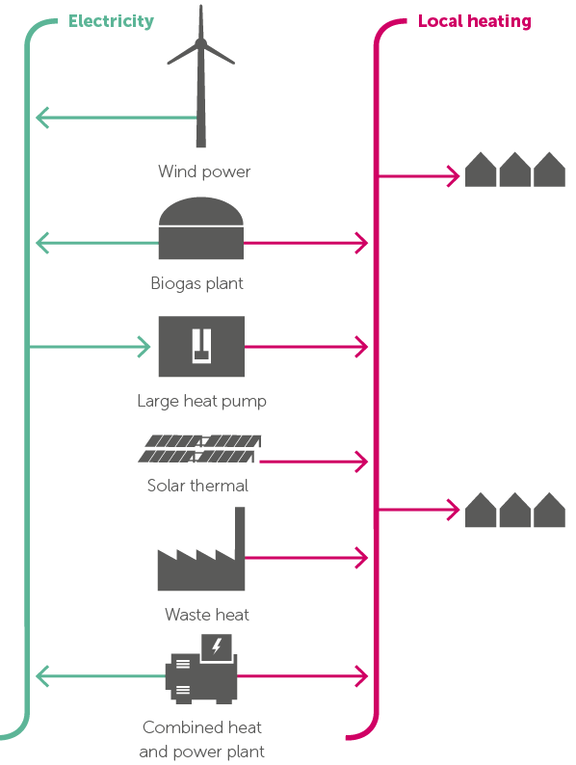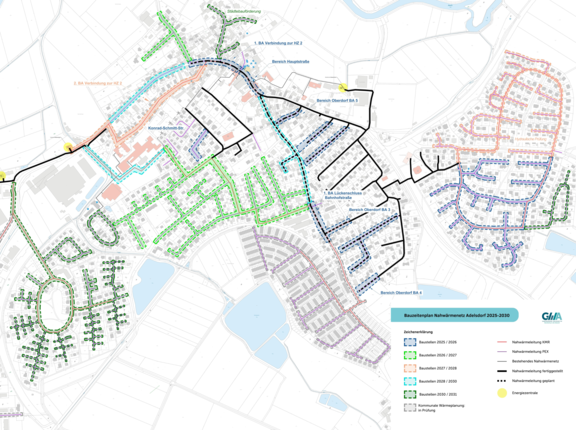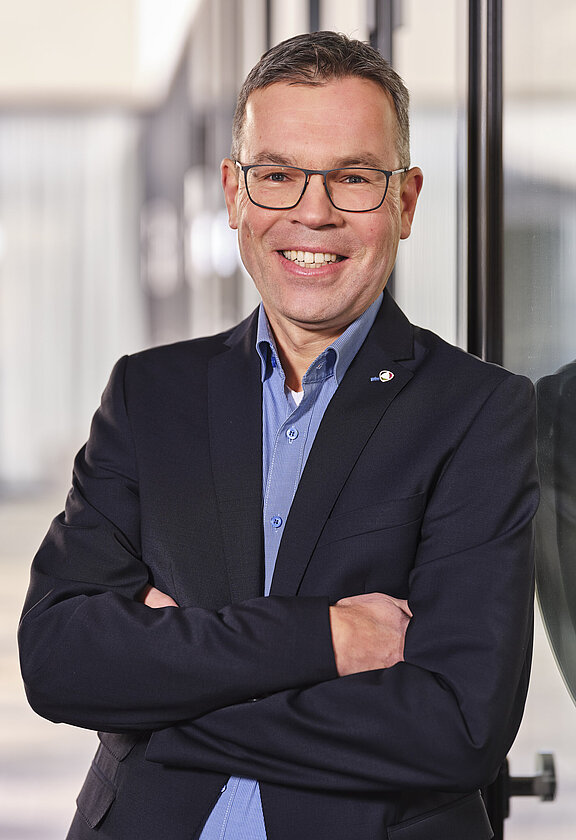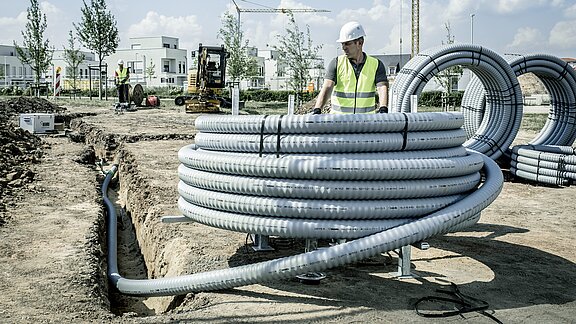
Decarbonisation of the heating supply
Compared to the electricity supply, there is much greater pressure to act in the heating sector, as more than 80 % of the heating supply in Germany is currently still based on fossil fuels (1). The focus here is on existing buildings. Municipal heat planning (KWP) is the central instrument for identifying locally available renewable energies (RE) for possible (centralised) use and for developing a heat transition strategy with a specific catalogue of measures. As a result of the KWP, heating network suitability areas can be localised as well as areas for which an individual building supply based on RE makes sense. The federal law on the KWP has been in force since January 2024. Municipal heating plans are to be available for all municipalities in Germany by mid-2028, and by mid-2026 for municipalities with more than 100,000 inhabitants (2). Example North Rhine-Westphalia: Here, implementation is flanked by a state law passed at the end of 2024, which is supported by a broad political base. Compared to all other federal states, the proportion of municipalities that have started the CHP process is the highest at more than 70 % (3).
Good reasons in favour of heating networks
Heat pumps will be the dominant heating system for individual buildings in the future. In densely built-up areas, combined solutions using heating networks often offer advantages. Renewable energy sources such as river heat or unavoidable waste heat from trade and industry as well as solar thermal energy can be tapped economically. In future, large heat pumps will be the main heat generators used here (Figure 1). In addition, the utilisation of (solid) biomass offers regional potential.
Funding programmes for the construction and expansion of heating networks
The construction and expansion of a heating network infrastructure is associated with high levels of investment. At federal level, there are three relevant funding programmes for financial support.
a) KWKG („Kraft-Wärme-Kopplungsgesetz“)
Combined Heat and Power Act
b) BEW („Bundesförderung für effiziente Wärmenetze“)
Federal subsidy for efficient heating networks
c) BEG („Bundesförderung für effiziente Gebäude“)
Federal subsidy for efficient buildings
Reliable framework conditions are essential for achieving this goal. This includes, in particular, sufficient funding for the federal subsidisation of efficient heating networks (BEW) that is independent of the federal budget. There is a need for action on the part of politicians in the new legislative period.
The wave of expansion will come
Based on the KWP, it can be expected that new heating networks will be built or existing networks will be expanded in many cities and municipalities. Initial heating plans already completed in 2024 indicate this potential. Take Eschwege in northern Hesse, for example: The results of the CHP have been available for the small town with around 20,000 inhabitants in the Werra-Meißner district since April 2024 (4). According to the target scenario for heat supply in 2045, 38 % of the town's heat demand could be covered by a new heating network, which would essentially be fed by a large heat pump with green heat (Fig. 2). 50 % would then be supplied decentrally by air-to-water heat pumps, 2 % by brine-to-water heat pumps and the remainder by wood pellet boilers in combination with solar thermal energy. For comparison: Based on the existing gas network structure, around 80 % of the final energy demand in Eschwege is still covered by fossil fuels based on natural gas. According to the KWP, the economically competitive heat production costs for the heating network expansion areas are between € 140 and € 149/MWh (net with subsidy). Taking the BEG subsidy into account, the costs for the decentralised supply of small individual buildings with a heating capacity of 10 kW are in the range of € 210 to € 250/MWh (net with subsidy). The example of Eschwege thus impressively demonstrates the technical and economic potential for the expansion of municipal local heating networks.

Challenges and responsibility
The transformation of the heating supply towards climate neutrality is a task for generations. The responsibility for implementation lies with the cities and municipalities, based on the Heat Planning Act. Success depends, among other things, on providing sufficient resources and involving the population through good communication, public relations and transparency. Without acceptance, there will be no successful implementation. With regard to the construction of municipal local heating networks, the local municipal utilities as well as other energy suppliers and contractors are responsible. This is where the expertise lies or needs to be further developed. In addition, a great deal of engineering expertise is required for planning as well as capacity in civil engineering and pipeline construction in order to build and expand the heating infrastructure. The omnipresent shortage of skilled labour, whether at municipal level or at municipal utilities and engineering service providers, is an obstacle. Measures that can help to simplify or speed up the process are in widespread demand.
Opportunities for accelerated network expansion
There is no alternative to the construction and expansion of heating networks with plastic-sheathed pipes („Kunststoffmantelrohrleitungen“ or „KMR“), i.e. with rigid steel media pipes, for large transport and main distribution lines due to the required transport capacity (pipe cross-sections) and the sometimes high temperature and pressure requirements in the supply networks. Beyond this, however, where the technical requirements allow it, openness to new or alternative technical solutions is required.
For operational implementation, it is an absolute gain if additional (new) capacities can be incorporated based on the use of flexible polymer pipe systems („polymerer Rohrsysteme“ or „PMR“). This includes, for example, civil engineering companies without special knowledge of KMR construction (e.g. required expertise and certifications for steel welding) or employees of municipal utilities. The advantages of PMR start with the planning process, which is simpler and faster. Thanks to the self-compensating nature of the pipework, neither pipe statics nor expansion bends are required (Fig. 3). The flexibility of the plastic pipes available as ring bundles can be utilised to advantage in the routing, e.g. when bypassing obstacles such as sewer pipes or manholes (Fig. 4). With rigid steel pipes, on the other hand, specially manufactured fitting pieces are required, e.g. in the event of a vertical offset in the route, which act as a cost driver (Fig. 5).
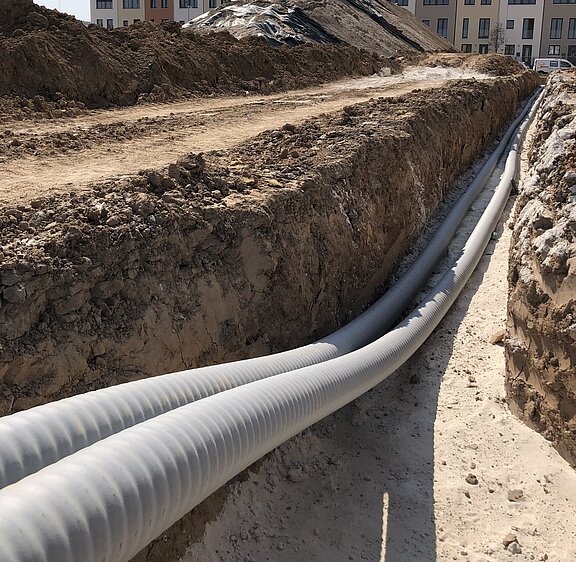
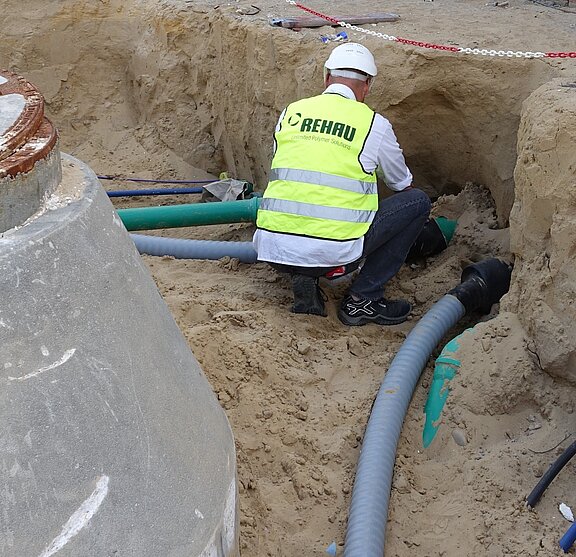

In PMR, a double pipe is widely used up to dimension d63/202 (specification with reinforced insulation) as a flexible system with a standard ring coil length of up to 75 metres. Double pipes are to be favoured especially in network operation due to the on average approx. 1/3 lower heat losses compared to single pipes. Single pipe systems generally dominate in KMR. The construction of double pipe systems is very challenging in terms of structural realisation, among other things with regard to the production of the weld seams at the joints. Conversely: If there is a possible change in technology from KMR single pipes to PMR double pipes, the cost advantage is also combined with an efficiency advantage due to a reduction in heat losses. When making a comparison, it is important to note that the cost advantage of PMR over KMR is not (primarily) achieved by the supposed saving in material costs. Rather, the cost reduction results from the overall consideration and inclusion of the different number of components and the effort involved in the necessary processing steps and, in particular, the additional savings in civil engineering.
The connection technology used in PMR, a sliding sleeve press system, is easy to process, extremely robust and, above all, safe (Fig. 6). The bottom line is that a PMR network (section) can be realised significantly faster. Interim conclusion: If technically suitable and with recognisable economic advantages, PMR systems and the combination of KMR + PMR should be used consistently in future, i.e. the best of both worlds should be used. With regard to specific projects, a basic distinction should be made between three categories:
a) Isolated networks
The first completed municipal heating plans show that decentralised heating network suitability areas (districts) are also being identified away from larger urban (partial) networks, where flexible polymer pipe systems can be used due to the size and total heat output (and the required pipe cross-sections derived from this) as well as the maximum temperature and pressure requirements. Polymer pipe systems are already widely and successfully installed in new-build neighbourhoods and have proven their worth in practice through cost savings and significantly shorter construction times (5, 6).
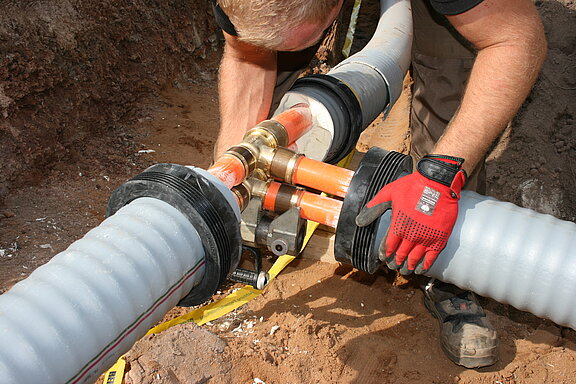
b) Secondary networks
Hydraulic decoupling enables a reduction in network temperatures and pressure levels as a prerequisite for a change of material from KMR to PMR in the secondary network (Fig. 7).
Especially where district heating networks already exist and are being expanded, PMR secondary networks offer considerable potential for reducing costs and accelerating implementation.
c) Hybrid networks
If the technical requirements for the overall network under consideration are met with regard to maximum operating temperature and pressure level, a hybrid network can be created. The design of the PMR component is not limited to the house connection lines, but generally includes the sub-distribution, e.g. in individual road sections. Which maximum dimension is economically advantageous for PMR compared to KMR depends on numerous boundary conditions. In individual cases, large PMR pipe dimensions are also preferred if the route has, for example, longer sections with many changes of direction and possibly vertical jumps, which would require a large number of moulded parts and fitting pieces with KMR. The interface from KMR to PMR can be realised, for example, by means of a parallel branch using universally weldable transition fittings, which are pressed on one side with the polymer pipes.
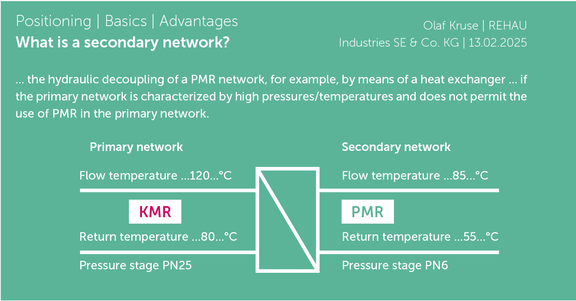
Practical examples of hybrid and secondary grids
Hybrid grids and secondary grids are not a new invention. There are already numerous successfully implemented projects that can set an example for the future. SOLARCOMPLEX AG, for example, has good experience with several hybrid grids that have been planned and built in the Lake Constance region and in the southern Black Forest over the last 10 years. Other projects in which the RAUTHERMEX polymer pipe system from REHAU was used in combination with KMR include those in Sebnitz near Dresden and Herbrechtingen/Baden-Württemberg.
In Adelsdorf, a municipality with around 9,500 inhabitants 40 kilometres north-west of Nuremberg, climate protection is being driven forward with great commitment through the establishment and expansion of a hybrid network (Figures 8 and 9). Initial experience with grid-connected heat supply was already gained in 2007 with the construction and operation of a district heating island network. The necessary establishment of municipal structures followed in 2022 with the founding of Gemeindewerke Adelsdorf. There is now a clear roadmap for replacing decentralised fossil-fuelled individual heating systems with the provision of green heat (Fig. 10). For housing companies and building owners, this offers security with regard to the fulfilment of legal requirements in accordance with the Building Energy Act. Adelsdorf is an example of how the necessary decarbonisation of the heat supply can be implemented in small and medium-sized municipalities.
On the western edge of Stralsund in Mecklenburg-Western Pomerania, the B-Plan 39 development area is being built with a total of 11 apartment blocks and 94 single-family homes. SWS is pursuing a clear strategy in Stralsund consisting of transforming the existing heating network infrastructure by successively integrating additional renewable heat sources and expanding the network to replace decentralised fossil heat generators. SWS is using plastic for the first time in B-Plan 39 and is relying on REHAU's expertise and the certified RAUTHERMEX PMR system (Fig. 11). Construction of the network began in spring 2023 and the first buildings have been supplied since the end of 2024. The secondary network is fed from the neighbouring KMR district heating network.
Conclusion & outlook
Accelerated expansion of the heating network infrastructure requires the deployment of additional capacities - especially in specialist planning and construction implementation. For engineering firms that are now (re)establishing themselves in this segment, the business prospects are extremely positive. For civil engineering and pipeline construction companies, training in the processing of polymer pipe systems is becoming significantly more important. This is being driven by clients, e.g. municipal utilities, who are increasingly recognising the potential of PMR. Flexible polymer pipe systems can make a substantial contribution to accelerating the decarbonisation of the heat supply beyond isolated networks when used in secondary and hybrid networks. With the change of material or the combination of KMR + PMR, experience has shown that up to approx. 1/3 of the investment costs can be saved in relation to the PMR part and the construction time can be significantly shortened. The prerequisite for sustainable success in the integration of PMR, even in larger networks, is compliance with guaranteed properties and a focus on durability and quality assurance in the overall system consisting of pipework, pipe connection technology and sleeves for post-insulation.
About the author:
Dipl.-Ing. (FH) Olaf Kruse
Product Engineer & Project Manager Local Heating
REHAU Industries SE & Co. KG
Contact:
REHAU Industries SE & Co. KG
Ytterbium 4
91058 Erlangen
Phone: +49 9131 92-5346
Email: Olaf.Kruse@rehau.com
gebaeudetechnik.rehau.de
Olaf Kruse has been working in the energy supply industry since 1995, initially in the field of consulting and planning, specialising in geothermal systems. In 2004, he moved into the industry to polymer specialist REHAU with responsibility for product development of solar thermal systems and drinking water heating systems. Since 2013, he has been contributing his extensive experience as a product engineer and project manager to local heating projects throughout Germany.
